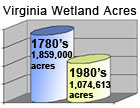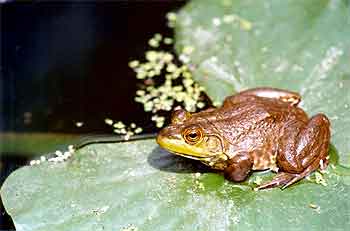
Wetlands of Prince William County & the Region
Wetlands. Just hearing the word calls up images of ducks skidding across the water, painted turtles sunning on fallen logs, dragonflies patrolling territories, wet feet and muddy shoes. Although we generally recognize wetlands as vegetated places where water is a dominant part of the environment, our perceptions of wetlands may not include all types. Wetlands are more varied and full of surprises than a casual glimpse reveals. Wetland is a collective term for a variety of habitats that link water and land. Marshes, bottomlands, swamps and vernal pools are all types of wetlands. Wetlands typically occur where water accumulates naturally in the landscape as a result of rainfall, groundwater seepage, or flooding. These low-lying areas are often located along drainage ways and flood plains, but also occur in upland areas where soil conditions restrict drainage. Wetlands may be as large as several hundred acres along tidal estuaries or small isolated pockets. Wetlands are divided into two main groups: inland (nontidal) wetlands and coastal (tidal) wetlands. Prince William's coastal and inland wetlands are a large part of why the County is special and unique. Lately wetland losses are getting more attention, both nationally and in Prince William. These legitimate concerns spring from the obvious signs of lost wetland functions, including increased flooding of lowlands, wildlife losses and muddy waterways. People weren't always concerned about wetlands, however. As late as the 1970's, these wet areas were viewed as wastelands to avoid or eliminate. Through the years, people have gone to considerable trouble and expense to dredge, drain, fill and transform wetlands into ‘useful' property. As a result, the United States has lost significant numbers of wetland acres to farming and development. Two hundred years ago wetlands covered 11% of the surface area of the lower 48 states. Today wetlands cover about 5% of this same area. The National Wetlands Inventory's 1982 report found that 9.2 million acres of wetlands (about the size of New Hampshire) were lost between the 1950's and 1970's. Although the Nation's 'No Net Loss' goals are still a reach today, the good news is that the rate of wetland losses is declining. The 1997 National Wetlands Inventory estimated that there were 105.5 million acres of wetlands in the lower 48 states. Ninety-five percent (100.5 million acres) were freshwater wetlands and 5% (5 million acres) were saltwater wetlands. The report shows that, between 1986 and 1997, a net of 644,000 acres were lost.
Virginia has lost 42% of its wetlands since the 1780's, and losses continue today. Within the 64,000 square mile Chesapeake Bay watershed, the greatest loss of forested wetlands in the Chesapeake Bay watershed has been in Virginia. Between 1982 and 1989, more than 17,800 acres of wetlands were lost in Virginia alone. These are meaningful statistics for Virginia. Wetlands are one of the most productive ecosystems in the world. Often called "Nature's Supermarket," wetlands attract a variety of wildlife. Virginia wetlands support the highest concentration of threatened and endangered species on the Atlantic Coast. Wetland functions are also valuable to human habitats. Wetlands function as natural "sponges," capturing, storing and slowly releasing water which protects our built environment from flooding. They buffer our coastal areas, where development pressures are especially great, from storms and control shoreline erosion. Wetlands improve water quality by acting as sediment traps, retain excess nutrients and help filter pollution. Some wetlands keep streams flowing during dry periods and many help replenish groundwater. Public interest in the renewal of natural ecosystems is growing steadily. Urban wetlands give residents a sense of wildness and open space. Properties that border wetlands often have higher values than those that do not. Wetlands have recreational, historical, scientific and culture values. Many people enjoy hiking, birding, canoeing, photographing wildlife and otherwise exploring Virginia's wetlands. Others simply enjoy nature's beauty and enjoy spending time observing plants and animals. From the Potomac River to the Piedmont, wetland areas make a significant contribution to Prince William's ecological diversity, protect our built environment, help clean our waterways and provide recreation opportunities. The quality of our local natural resources impacts the quality of our community environment. Wetlands are important assets that provide local benefits and need local protection. |
Maps | Photos | Publications | Youth Education | FAQ's | Links | Membership


